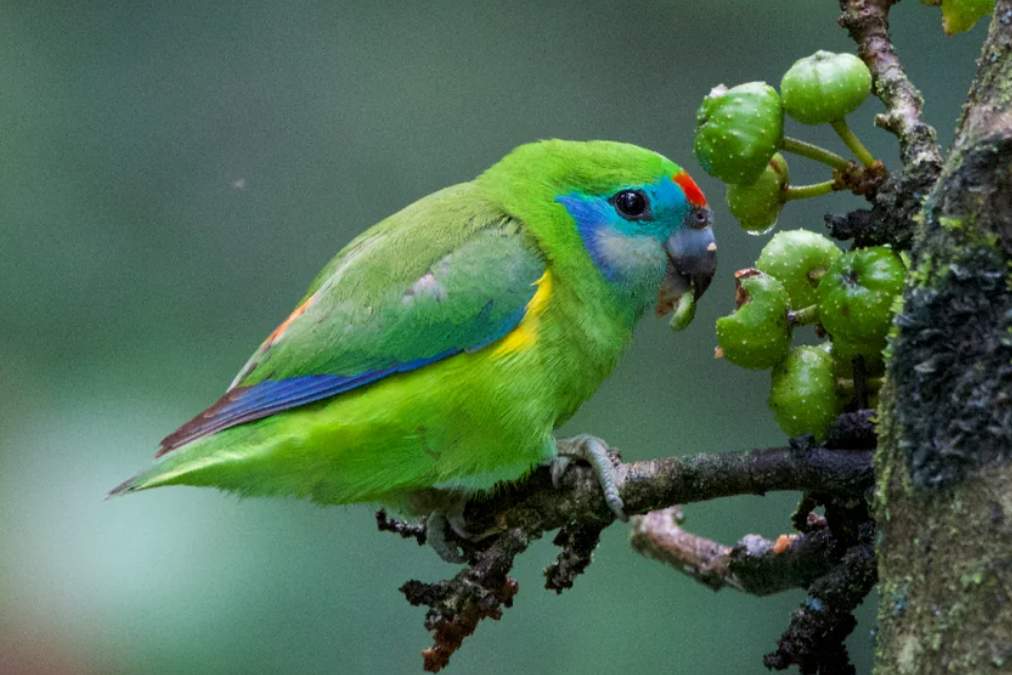Warm, musical warbles fill the air as groups of male White-cheeked Honeyeaters (Phylidonyris nigra) advertise the onset of the breeding season. It is also known as Moustached Huneyeater. As he ascends from his perch near the nest, the male begins to chirp and whistle as he marks his territory with his main song. A bird stalling in midair and quivering its wings generates the loudest sound when at the apex of its flight.
As he descends, he chirps and whistles and descends more slowly than he rose. The White-cheeked Honeyeater nests in loose colonies when nectar and insects are available, and the male spends much of the time singing or sitting on a strategically placed perch near the nest while the female builds and incubates. The size of the White-cheeked Honeyeater is about 170-180 mm in length.
White-cheeked Honeyeaters are not strictly territorial, but the males defend the nest site and a few vantage perches against other honeyeaters. The male’s singing becomes less frequent after the eggs hatch when both parents are occupied catching insects to feed to the young. Successful nesting depends upon an abundance of nectar—the main food of adults-not only as food for the nestlings but as a source of energy for the parents, who spend much time hawking for insects for the nestlings.

Plants such as banksias, dryandras, eucalypts, angophoras, grevilleas, tea trees, and paperbarks provide nectar-rich flowers that they visit hurriedly. Following the family’s departure from the nest to wander through the heath or forest understory, the parents continue to feed the young.
Following fledging, family groups tend to stay together for some time, but when the young are fully grown, larger groups often gather. A wandering band of adults and young birds seeks to blossom during the non-breeding season. In aggregations, White-cheeked Honeyeaters are extremely animated and noisy, as they are seemingly bold birds who advertise their presence with loud chatter and loud squabbles.
In eastern Australia, the White-cheeked Honeyeater is a common resident of coastal heaths and woodlands with a dense understory of flowering plants. However, in southwestern Australia, its distribution is patchy; it is abundant in some parts of the range and rare in others. Its dark brown eye and big white cheek patch set it apart from the related New Holland Honeyeater.
Both sexes are similar; males are slightly larger. Upper parts—head to wings and tail-black, thinly striped white un back; flight and tail feathers edged broadly yellow; tail tipped white. Face black with lung, broad white brow; broad white cheek patch which is flared (eastern race) or tapered (western race). Throat plain black; breast to undertail white and steaked black. Eyes are black-brown. Bill is black. The feet are dark grey.
The immature bird is a little browner and greyer than adults; the eyebrows are broader; and there is a yellow tint on lores. White-cheeked Honeyeater is found in coastal heaths and heath woods on the southwestern mainland and from Athertun Tablelands, Queensland, to Wallaga Lake, NSW, in the east. There are two races; one in the East and one in the West.
The White-cheeked Honeyeater call is harsh but metallic chak-a-chak or chip-choo from perch; chattering tee-tee-tee, rapidly repeated, probably in alarm. The song consists of loud, prolonged whistled chip-choo-chippy-choo coupled with musical twee-ee-twee-ee in flight or from perch.
Nesting and breeding occur in August and November, as well as in March and May. Nest a cup of plant fiber, bark, and grass tightly woven together; lined with soft material such as banksias flowers, or cobwebs and soft plant material, placed low in dense vegetation and usually within 1 meter of the ground. White-cheeked Honeyeater lays 1 to 3 usually 2 eggs, which are pale buff with pink or red-brown spots at the larger end; oval, about 21 x 15 mm. 1ncubatiun 14-15 days, by female. The chick fledges in two weeks.
Read More: Yellow-throated Honeyeater (Nesoptilotis flavicollis)







